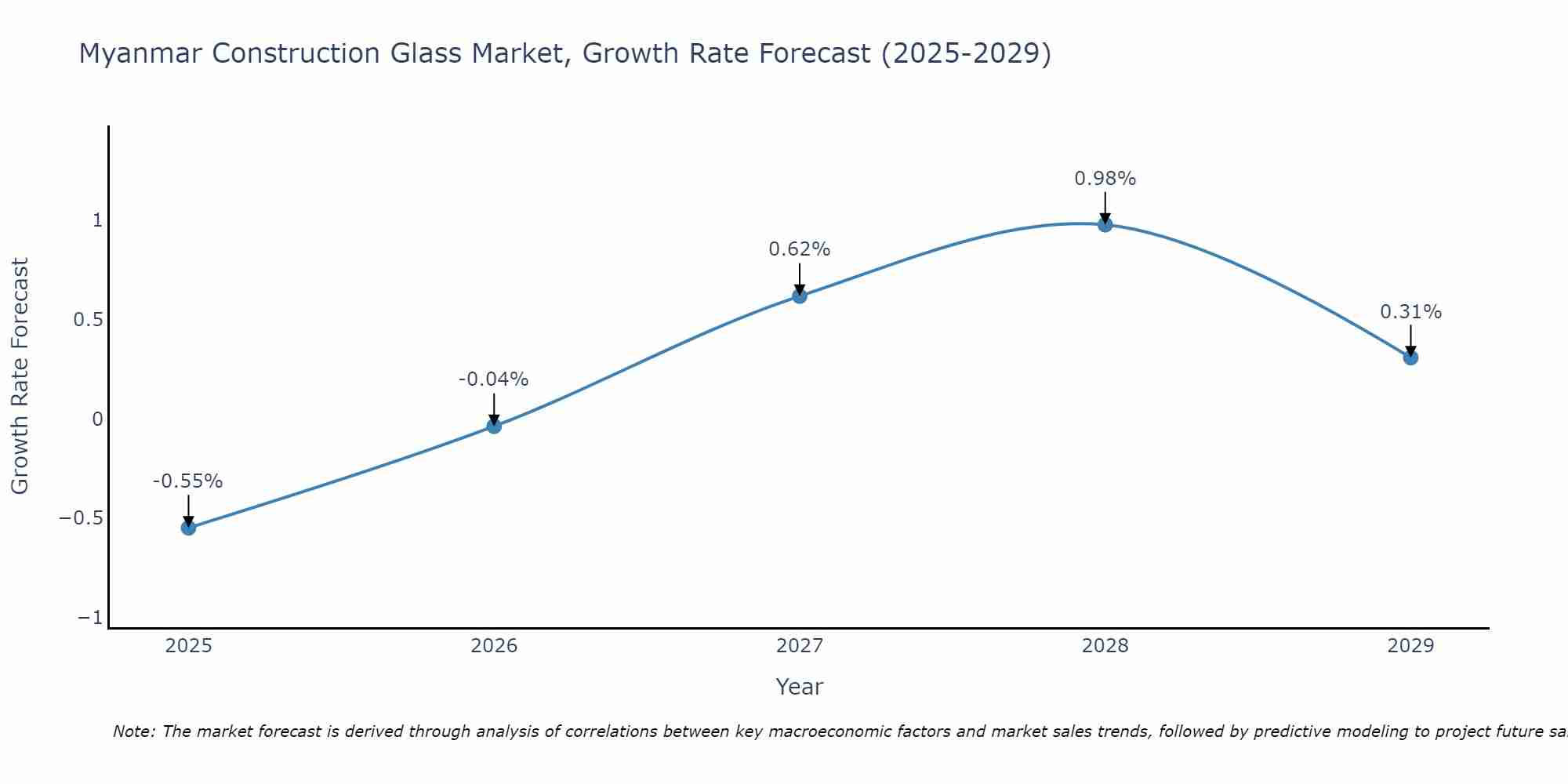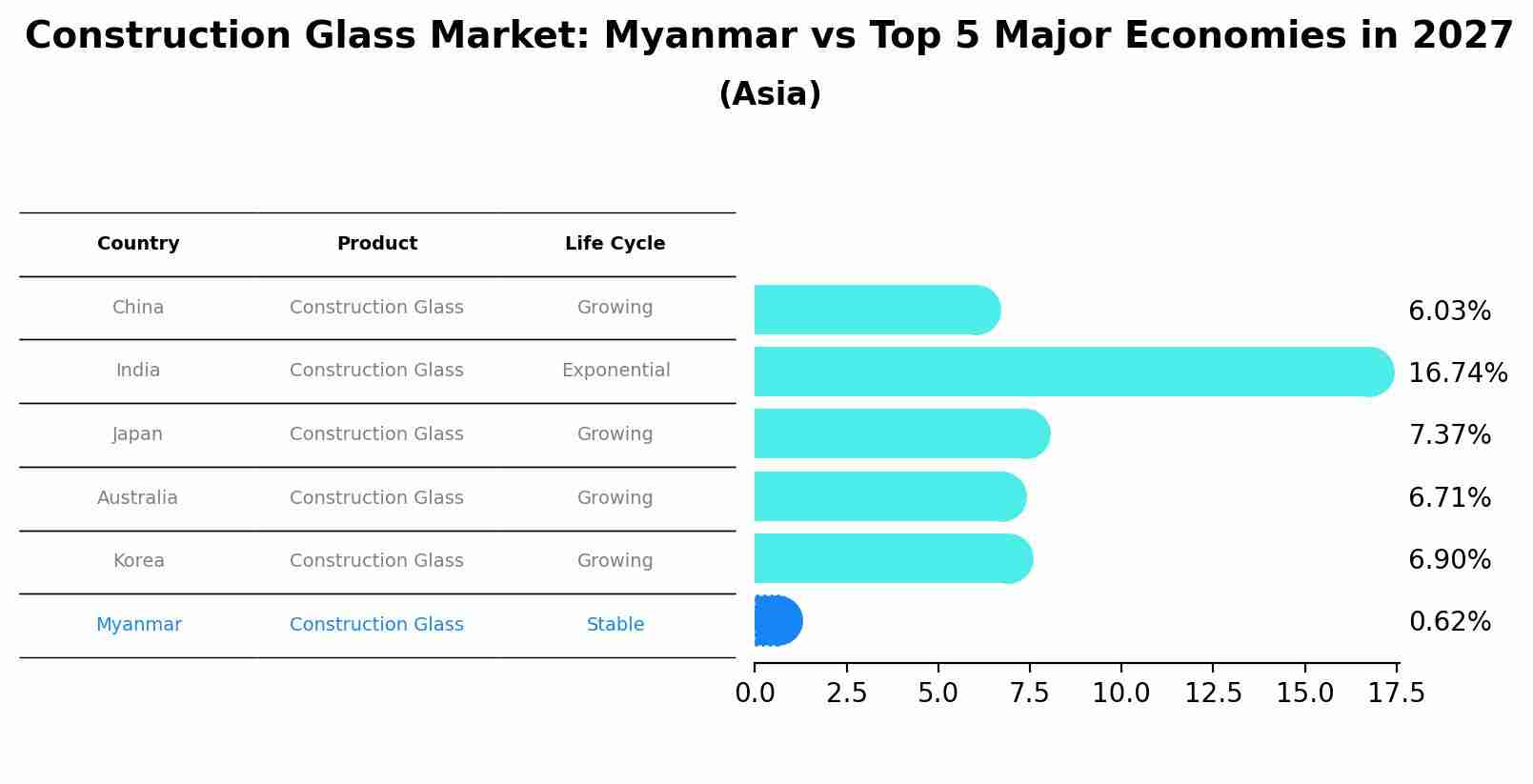Myanmar Construction Glass Market (2025-2031) Outlook | Share, Industry, Companies, Forecast, Revenue, Value, Trends, Growth, Analysis & Size
| Product Code: ETC355354 | Publication Date: Aug 2022 | Updated Date: Aug 2025 | Product Type: Market Research Report | |
| Publisher: 6Wresearch | Author: Shubham Padhi | No. of Pages: 75 | No. of Figures: 35 | No. of Tables: 20 |
Myanmar Construction Glass Market Size Growth Rate
The Myanmar Construction Glass Market is projected to witness mixed growth rate patterns during 2025 to 2029. Growth accelerates to 0.98% in 2028, following an initial rate of -0.55%, before easing to 0.31% at the end of the period.

Construction Glass Market: Myanmar vs Top 5 Major Economies in 2027 (Asia)
The Construction Glass market in Myanmar is projected to grow at a stable growth rate of 0.62% by 2027, within the Asia region led by China, along with other countries like India, Japan, Australia and South Korea, collectively shaping a dynamic and evolving market environment driven by innovation and increasing adoption of emerging technologies.

Myanmar Construction Glass Market Overview
The construction glass market in Myanmar is witnessing steady growth, driven by the increasing demand for glass products in the construction of commercial and residential buildings. With the growing focus on energy efficiency and sustainability, there is a rising demand for high-performance glass products that offer thermal insulation and soundproofing properties.
Drivers of the market
The construction glass market in Myanmar is experiencing growth due to the increasing adoption of glass in architectural applications, including facades, windows, and interior partitions. Factors such as urbanization, changing consumer preferences for aesthetically appealing structures, and advancements in glass manufacturing technology drive market expansion. Moreover, the emphasis on energy efficiency and sustainability encourages the use of high-performance glass products in construction projects.
Challenges of the market
The construction glass market in Myanmar encounters various challenges that hinder its progress. One notable obstacle is the lack of advanced manufacturing facilities capable of producing high-quality, energy-efficient glass products. Moreover, the industry faces competition from imported glass products, which often meet higher quality standards at competitive prices. Additionally, concerns regarding the environmental impact of glass production and disposal raise questions about the sustainability of the market`s growth trajectory. Furthermore, the absence of comprehensive building codes and regulations addressing the use of glass in construction adds complexity to market dynamics. These challenges collectively pose barriers to the expansion and modernization of the construction glass market in Myanmar.
Government Policy of the market
Policies in the construction glass market may focus on product quality, energy efficiency, and safety standards. The government may implement regulations to ensure that construction glass meets specified performance criteria, such as resistance to impact and thermal insulation properties. Additionally, there may be incentives or requirements for the use of energy-efficient glass in building projects to promote sustainability and reduce energy consumption.
Key Highlights of the Report:
- Myanmar Construction Glass Market Outlook
- Market Size of Myanmar Construction Glass Market, 2024
- Forecast of Myanmar Construction Glass Market, 2031
- Historical Data and Forecast of Myanmar Construction Glass Revenues & Volume for the Period 2021-2031
- Myanmar Construction Glass Market Trend Evolution
- Myanmar Construction Glass Market Drivers and Challenges
- Myanmar Construction Glass Price Trends
- Myanmar Construction Glass Porter's Five Forces
- Myanmar Construction Glass Industry Life Cycle
- Historical Data and Forecast of Myanmar Construction Glass Market Revenues & Volume By Chemical Composition for the Period 2021-2031
- Historical Data and Forecast of Myanmar Construction Glass Market Revenues & Volume By Soda-lime for the Period 2021-2031
- Historical Data and Forecast of Myanmar Construction Glass Market Revenues & Volume By Potash-lime for the Period 2021-2031
- Historical Data and Forecast of Myanmar Construction Glass Market Revenues & Volume By Potash-lead for the Period 2021-2031
- Historical Data and Forecast of Myanmar Construction Glass Market Revenues & Volume By Type for the Period 2021-2031
- Historical Data and Forecast of Myanmar Construction Glass Market Revenues & Volume By Low-e Glass for the Period 2021-2031
- Historical Data and Forecast of Myanmar Construction Glass Market Revenues & Volume By Special Glass for the Period 2021-2031
- Historical Data and Forecast of Myanmar Construction Glass Market Revenues & Volume By Manufacturing Process for the Period 2021-2031
- Historical Data and Forecast of Myanmar Construction Glass Market Revenues & Volume By Float Process for the Period 2021-2031
- Historical Data and Forecast of Myanmar Construction Glass Market Revenues & Volume By Rolled/sheet Process for the Period 2021-2031
- Historical Data and Forecast of Myanmar Construction Glass Market Revenues & Volume By Application for the Period 2021-2031
- Historical Data and Forecast of Myanmar Construction Glass Market Revenues & Volume By Residential for the Period 2021-2031
- Historical Data and Forecast of Myanmar Construction Glass Market Revenues & Volume By Commercial for the Period 2021-2031
- Historical Data and Forecast of Myanmar Construction Glass Market Revenues & Volume By Others for the Period 2021-2031
- Myanmar Construction Glass Import Export Trade Statistics
- Market Opportunity Assessment By Chemical Composition
- Market Opportunity Assessment By Type
- Market Opportunity Assessment By Manufacturing Process
- Market Opportunity Assessment By Application
- Myanmar Construction Glass Top Companies Market Share
- Myanmar Construction Glass Competitive Benchmarking By Technical and Operational Parameters
- Myanmar Construction Glass Company Profiles
- Myanmar Construction Glass Key Strategic Recommendations
Frequently Asked Questions About the Market Study (FAQs):
- Single User License$ 1,995
- Department License$ 2,400
- Site License$ 3,120
- Global License$ 3,795
Search
Thought Leadership and Analyst Meet
Our Clients
Related Reports
- Canada Oil and Gas Market (2026-2032) | Share, Segmentation, Value, Industry, Trends, Forecast, Analysis, Size & Revenue, Growth, Competitive Landscape, Outlook, Companies
- Germany Breakfast Food Market (2026-2032) | Industry, Share, Growth, Size, Companies, Value, Analysis, Revenue, Trends, Forecast & Outlook
- Australia Briquette Market (2025-2031) | Growth, Size, Revenue, Forecast, Analysis, Trends, Value, Share, Industry & Companies
- Vietnam System Integrator Market (2025-2031) | Size, Companies, Analysis, Industry, Value, Forecast, Growth, Trends, Revenue & Share
- ASEAN and Thailand Brain Health Supplements Market (2025-2031) | Strategy, Consumer Insights, Analysis, Investment Trends, Opportunities, Growth, Size, Share, Industry, Revenue, Segments, Value, Segmentation, Supply, Forecast, Restraints, Outlook, Competition, Drivers, Trends, Demand, Pricing Analysis, Competitive, Strategic Insights, Companies, Challenges
- ASEAN Bearings Market (2025-2031) | Strategy, Consumer Insights, Analysis, Investment Trends, Opportunities, Growth, Size, Share, Industry, Revenue, Segments, Value, Segmentation, Supply, Forecast, Restraints, Outlook, Competition, Drivers, Trends, Demand, Pricing Analysis, Competitive, Strategic Insights, Companies, Challenges
- Europe Flooring Market (2025-2031) | Outlook, Share, Industry, Trends, Forecast, Companies, Revenue, Size, Analysis, Growth & Value
- Saudi Arabia Manlift Market (2025-2031) | Outlook, Size, Growth, Trends, Companies, Industry, Revenue, Value, Share, Forecast & Analysis
- Uganda Excavator, Crane, and Wheel Loaders Market (2025-2031) | Strategy, Consumer Insights, Analysis, Investment Trends, Opportunities, Growth, Size, Share, Industry, Revenue, Segments, Value, Segmentation, Supply, Forecast, Restraints, Outlook, Competition, Drivers, Trends, Demand, Pricing Analysis, Competitive, Strategic Insights, Companies, Challenges
- Rwanda Excavator, Crane, and Wheel Loaders Market (2025-2031) | Strategy, Consumer Insights, Analysis, Investment Trends, Opportunities, Growth, Size, Share, Industry, Revenue, Segments, Value, Segmentation, Supply, Forecast, Restraints, Outlook, Competition, Drivers, Trends, Demand, Pricing Analysis, Competitive, Strategic Insights, Companies, Challenges
Industry Events and Analyst Meet
Whitepaper
- Middle East & Africa Commercial Security Market Click here to view more.
- Middle East & Africa Fire Safety Systems & Equipment Market Click here to view more.
- GCC Drone Market Click here to view more.
- Middle East Lighting Fixture Market Click here to view more.
- GCC Physical & Perimeter Security Market Click here to view more.
6WResearch In News
- Doha a strategic location for EV manufacturing hub: IPA Qatar
- Demand for luxury TVs surging in the GCC, says Samsung
- Empowering Growth: The Thriving Journey of Bangladesh’s Cable Industry
- Demand for luxury TVs surging in the GCC, says Samsung
- Video call with a traditional healer? Once unthinkable, it’s now common in South Africa
- Intelligent Buildings To Smooth GCC’s Path To Net Zero


















